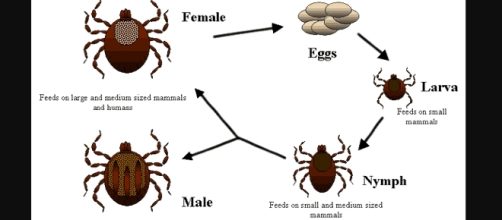The most commonly recognized and widely publicized diseases that are transmitted through tick bites are Lyme's Disease and Rocky Mountain Spotted Fever. The second of the two diseases are often fatal while the tick that transmits it is not specific to the area it was named after. It is also prevalent in the mid-Atlantic states and treatment must begin within five days following the onset of symptoms which include fever, headache, abdominal and muscle pain, and vomiting. Some tick transmitted diseases cause a rash according to the Centers for Disease Control (CDC).
For example, Lyme disease is a southern tick illness that is associated with a rash.
Several different diseases are carried by different tick species
The Lone Star tick is known for causing some of its victims to develop a meat allergy for which there is no known treatment. The Hunting Page reported that the tick's name is derived from a distinct white marking on its back and that it carries a sugar molecule called alpha-1, 3-galactose, or Alpha-Gal for short, that affects the victim's immune system. Lone Star ticks have been recorded in large numbers as far north as Maine and as far west as Central Texas and Oklahoma over the past twenty to thirty years. Another disease that is only common to Wisconsin, Minnesota, New York, and Massachusetts is the Powassan Virus.
Approximately seven cases a year of Powassan Virus were reported from 2006 to 2015. However, experts worry that number could eventually increase. Related to the West Nile virus that is carried by mosquitos, the CDC reports that it is carried by several different ticks, specifically the Ixodes cookei and Ixodes marxi, which rarely bite humans.
But the Powassan Virus is now showing up in deer ticks, the same species that carry Lyme Disease. Unlike Lyme Disease where the tick must be attached to a person for thirty-six to forty-eight hours, transmission of the Powassan Virus can take place fifteen minutes after the tick becomes attached to someone.
Taking preventative measures is the best protection against tick bites
At one time ticks were more prevalent in wooded areas with a lot of trees and thick grass or other foliage. But with climate changes resulting in longer summer and autumn seasons along with shorter and cooler winters in many areas of the country, ticks have spread across the U.S. and now live and thrive in back yards, gardens, and grassy lots. When walking or hiking in areas where ticks are more prevalent stick to the sidewalk or defined paths if possible, wear long sleeves with buttons at the wrists or tie something around them, long pants, and use repellant. It is best to wear boots or high topped walking shoes and tuck long pants into them.
There is even treated protective clothing available. The Environmental Protection Agency and the CDC tout using a repellent containing at least 20% deet, picaridin, or IR3535. Adults should apply the creams or sprays to the skin of children and teens, avoiding the hands, eyes, and mouth. The EPA also has a tool that has information on protection and prevention, the different species of ticks and what states they can be found in.
Checking for ticks
After a hike or being outdoors in grassy or wooded parks or yards, every person and pet should take a shower as soon as possible to wash off any ticks that have not yet embedded themselves under the skin. Next, a full body check needs to be done using a hand held or full-length mirror, or adults can check each other's bodies.
Adults should also check for ticks on children especially under the arms, at the waist and in the navel, behind the knees, in their hair, the back of the neck, and in and around the ears. Also check pets, socks, and shoes both inside and out as ticks will hitch a ride. Look inside purses and pockets, as well. Another good precaution is to immediately wash everyone's clothing in hot water and dry in a hot dryer depending on the material the clothing is made off. Prevention and follow-up tick checks are paramount to decreasing the chances of getting a disease from a tick bite.


